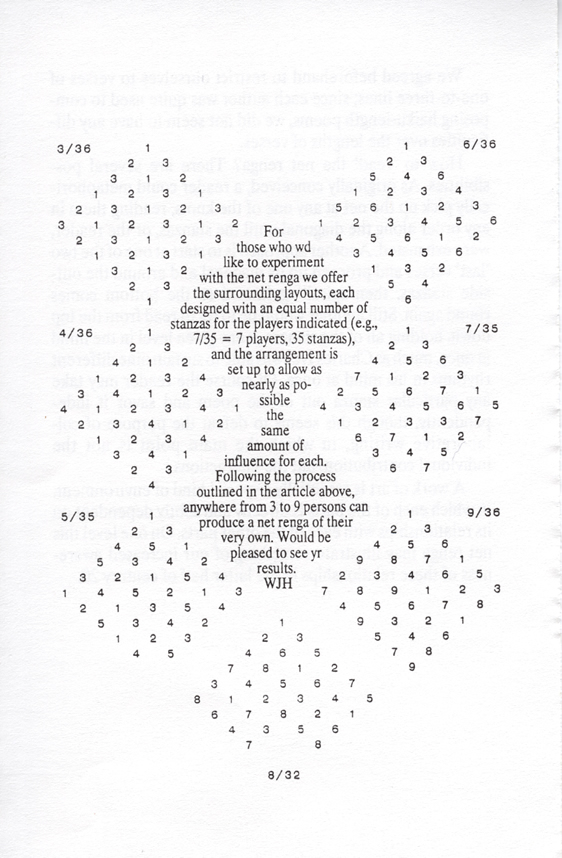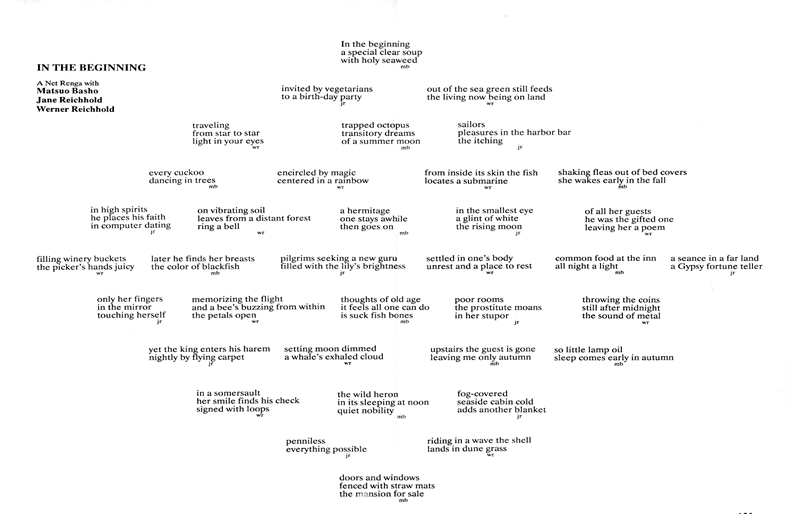|
Lesson Ten
Renga Varitions - Net and Pyramid Renga
On Composing Net Renga
William J. Higginson
(reprinted from Haiku Magazine, Volume 6, No. 3, Copyright © by From Here Press, 1976. Used by permission of author/publisher in Narrow Road to Renga, Jane Reichhold Editor, AHA Books, 1989)
The five-by-five square or diamond shape was chosen because it produced handleable unit of twenty-five stanzas. (A Japanese friend notes that a six-by-six would have given us the classical thirty-six stanzas;
I don't know if we would have had the stamina.) The bottom point was omitted in order to give each of the three authors an equal number of stanzas. The pattern in which the authors' verses appear was also
determined prior to composition. This one seemed to allow for the maximum amount of inter-author stimulation.
Once the pattern was agreed upon, the poem was poem was composed in a succession of horizontal levels. One of the poets acted as recorder. After the top verse was composed, the other two poets
independently wrote their verses in response to it on the second horizontal. Each wrote without knowing what the other was doing. The results were given to the recorder, who then distributed copies of the
upper triangle of three stanzas to each poet. On this round each poet had to compose a stanza which connected in some way with the nearest verse diagonally above. Again each poet worked without knowing
what his cohorts were doing on that same level.
Early in the game, the authors realized that one of the features accidentally built into the design is vertical chains of stanza all by the same author. Since each of us had written haiku sequences, we agreed
that each could tie also his vertical stanzas into a sequence. This was particularly true for the four-stanza sequence down the middle of the poem. The added feature may seem to go against the always-
changing direction principle of renga, but provided added fun for the authors.
We agreed beforehand to restrict ourselves to verses of one-to-three lines; since each author was quite used to composing haiku-length poems, we did not seem to have any difficulties over the length of verses.
How to 'read; the net renga? There are several possibilities. As originally conceived , a reader could metaphorically puck up the net at any one of the knots, reading them in any order along the diagonal until
the stanzas or the reader were exhausted. Another approach is to start at one of the two 'last' verses and proceed up its diagonal and round the outside stanzas. Still another would be to try to read from the top down,
holding all the stanzas at any given level in the mind at once, much as Chiles Ives was able to sustain nine different rhythms in his mind at once. Of course the reader may take any particular stanza out of the poem
and savor it independently, though this seems to defeat the purpose of collaborative writing, in which the main point is not the individual contribution, but the interactions.
A work of art is essentially a special kind of environment, in which each of the part is directly and subtly dependent on its relationships with each of the other parts. One one level this net renga may illustrate something of our increased awareness of these
relationships in the latter half of century 20.
###
I am now amazed that I printed this in Narrow Road to Renga without ever knowing who the other authors were or ever seeing the poem they published. If anyone has information on this, please get in touch as
I feel we are missing something. What I can bring to you is the schema from Haiku Magazine that shows the various plans the author worked out for different numbers of people doing a net renga.

As far as I know very few net renga were ever written and I only have the four that were published in Narrow Road to Renga. Werner Reichhold wrote in two and did a solo net renga, I did a solo net renga and both Werner
and I did one with Elaine Sherlund, a member of the Gualala Arts Haiku Group, and this one we did using links from Matsuo Basho. At the time we used templates with the link numbers, and line numbers printed out for
each stanza. We worked it much as Bill Higginson did, starting with the hokku at the top and then the next two stanzas both linking back to the first one.

Another experiment in the net renga was a more extensive experiment I made with my daughter Bambi Walker – Steiner we called the pyramid renga. Under the influence of Jim Wilson’s work with the expanding or blossoming renga. we got the idea one dark and stormy night to see how far we could push theconcept by adding multiple stanzas to any one link.
We spread out a huge sheet of butcher paper on the floor and at the top in the middle and I started with the hokku:
ocean fog
in the broken sign
open
Then we threw the I-Ching coins to determine how many links to the hokku Bambi would write. She got all three inscribed so she created three versions of the renga by writing three two-liners to the hokku.
Then it was my turn to write a three-liner. I threw the coins for each of the three versions and from those numbers wrote one to three links for each version. As you can image the renga quickly began to spiral out of control. However, there were times when none of the coins came up ‘inscribed’ so that meant, we said, that that branch of the renga was finished.
We spent that night and several days later crawling around on the floor as we drew lines from link to link. The work got so gigantic that we quit at 18 links with over 300 stanzas.
Amazed and delighted with ourselves we figured out a way to get the whole work into a computer and then to print out pages of different lengths so it is possible to read the work like a book. We named it A Literary Curiosity; The Pyramid Renga “OPEN” and we printed, collated, hole punched, and comb-bound 50 copies. I still have a few up in some closet gathering dust.
A page from A Liteary Curosity: The Pryamid Renga "OPEN"
by Jane Reichhold and Bambi Walker (Steiner)
Previous lesson
Next lesson
|